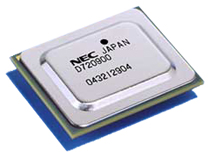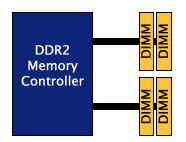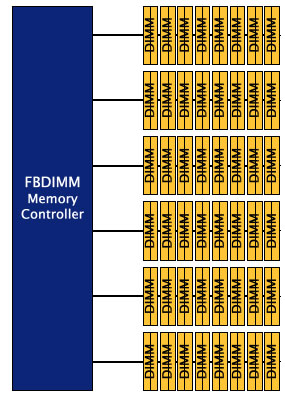 The AMB (Advanced Memory Buffer) chip is key to the
performance of FB-DIMM memory.
The AMB (Advanced Memory Buffer) chip is key to the
performance of FB-DIMM memory.
The AMB chip in each FB-DIMM module is linked to the chip in the next module
via a bi-directional serial interface. The AMB in the first memory module
connects to the memory controller on the motherboard by way of the same
high-speed serial interface. In essence, the AMB chips form a data highway that
starts at the memory controller and passes through each module in turn. The DDR2
memory DRAM chips on each FB-DIMM module load data onto this highway via the AMB
chip on the same module.
When multiple FB-DIMM memory modules occupy the same channel, each AMB acts as
a repeater for the modules 'behind' it in the signal path. Data from the
farthest modules is repeated by each closer module and daisy-chained with new
data. The AMB closest to the memory controller hosts the primary
connection and transfers all data to and from the rest of the system.
Fully buffered?
Like registered memory, FB-DIMM modules are buffered; this allows multiple
DIMMs to precisely co-ordinate data transfer for maximum stability.
Conventional registered memory only buffers the address lines, while FB-DIMM
modules buffer both address and data lines. What does this mean? It
means that every bit of data read or written from FB-DIMM memory is precisely
coordinated by the memory controller and the AMB (Advanced Memory Buffer) chip
on each module.
Potential Speed Advantages over DDR2
 FB-DIMM has several built-in advantages over contemporary memory technology
which should enable it to transfer data faster standard server DDR2 RAM, even
though it is fully buffered and performs error checking.
FB-DIMM has several built-in advantages over contemporary memory technology
which should enable it to transfer data faster standard server DDR2 RAM, even
though it is fully buffered and performs error checking.
The bi-directional serial interface can send and receive data simultaneously,
which instantly eliminates the read-to-write latency associated with
conventional memory. The links themselves have a bandwidth of 3.2GB/s, 4.0GB/s or
4.8GB/s depending on the type of DDR2 memory being used in the FB-DIMM modules
(DDR2-533, 667 or 800).
Since the serial links have a lower pin-count than conventional memory buses
and better data handling abilities, more channels can be implemented in a single
memory controller. In entry-level servers and high-end desktops, four
FB-DIMM modules, each with a channel of their own will have a considerable
bandwidth advantage over a conventional dual-channel memory controller
supporting two DDR2 DIMMS on each channel.

On the other hand, the initial latency of serial memory is said to be higher
than that of traditional memory setups, though this disadvantage disappears with
continuous transfers of data, where the inherently faster speed of the serial
memory interface and its bi-directional nature come out on top.
Potential Capacity advantages over DDR2
Capacity is where FB-DIMM really does seem to have a clear-cut advantage over
conventional memory. Since the 32-bit server should be nothing but a
memory by next year, the focus for performance is likely to shift a bit more
towards the memory as opposed to the processor(s) in any given server.
Where previously there was a hard 4GB memory limit which required some creative
(and performance sapping) memory addressing tricks to overcome, modern 64-bit
processors can potentially address effectively unlimited amounts of memory at
full speed.
Currently, FB-DIMM technology supports up to six channels
of eight dual-layer FB-DIMM modules each. This gives a maximum of
192GB
of memory addressed by
a single memory controller!
Error checking
Similar to ECC (Error Checking and Correcting) memory, FB-DIMM modules perform
error checking and correction as well as cyclic redundancy checks on data
passing through them, thanks again to the AMB chip. The AMBs in each
memory channel co-ordinate their error checking efforts so that if a correction
or retry is necessary, all the modules stay in sync.
